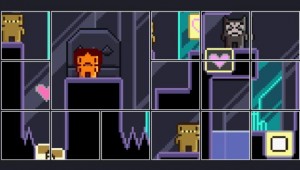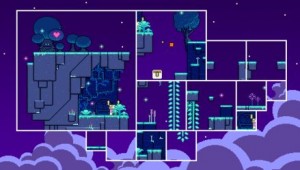 I recently had spirited but invigorating debate with a games developer who is thoroughly opposed to what she considers to be (and I apologise if I paraphrase her poorly) “arty games”. The gist of her argument was that many indie developers replace solid gameplay fundamentals with misplaced artistic sentiment and thinly veiled metaphors for love, loss and existential angst. Games like But That Was [Yesterday], Don’t Look Back and Girl With a Heart Of are all games that wear their overt sentimentality on their metaphorical sleeve, and Where is My Heart is very much in the same vein. The question is, will it appeal to those who want more than an emotional hot chocolate with marshmallows?
I recently had spirited but invigorating debate with a games developer who is thoroughly opposed to what she considers to be (and I apologise if I paraphrase her poorly) “arty games”. The gist of her argument was that many indie developers replace solid gameplay fundamentals with misplaced artistic sentiment and thinly veiled metaphors for love, loss and existential angst. Games like But That Was [Yesterday], Don’t Look Back and Girl With a Heart Of are all games that wear their overt sentimentality on their metaphorical sleeve, and Where is My Heart is very much in the same vein. The question is, will it appeal to those who want more than an emotional hot chocolate with marshmallows?
I am pleased to answer that Where is My Heart? by Bernie Schulenburg does have a solid gameplay core. There is a central gameplay conceit that is as concrete and engaging as the grandaddy of arty 2D platformers: Braid. Whereas Braid uses time as a gameplay mechanic to that the player must manipulate, Where is My Heart? challenges the player by splitting the screen up into panels that are laid out all over the screen, but are not necassarily next to each other in the game world. This is hard to explain in text, but immediately obvious if you watch just a few seconds of gameplay footage.
The difficulty of navigating the spatially challenging environment is complicated by the special abilities of the three playable characters. These three cute little dudes are the team that you control throughout the game. None of them can jump very high or move very fast, but they can stand on each others heads to reach higher areas. Additionally, each has an alter ego that completely changes the ruleset of the game. For example, one can double jump, while another can rotate the panels that the game is played on, allowing him to appear in a totally different part of the level. These transformations create genuinely innovative puzzles that require a great deal of lateral thinking and while early efforts can be solved through trial and error, later puzzles require a good deal of cunning and creativity to solve.
 Bernie Schulenburg has crafted an ugly/pretty aesthetic for the game. Intentionally pixelated, there’s a deliberate retro flavour to the visuals throughout the story. At times the visuals will look basic but sharp when the levels are large, but when they are smaller the characters appear larger and far more retro with sharp edges and pixels so large you can count them. This actually works in the games favour; its obvious that its a choice the developer has made rather than a graphical shortcoming. Its jarring to see the pretty, small sprites get so ugly when they are viewed up close, but it re-engages the player each time it happens, fondly reminding them of Atari or NES games (if they ever played them).
Bernie Schulenburg has crafted an ugly/pretty aesthetic for the game. Intentionally pixelated, there’s a deliberate retro flavour to the visuals throughout the story. At times the visuals will look basic but sharp when the levels are large, but when they are smaller the characters appear larger and far more retro with sharp edges and pixels so large you can count them. This actually works in the games favour; its obvious that its a choice the developer has made rather than a graphical shortcoming. Its jarring to see the pretty, small sprites get so ugly when they are viewed up close, but it re-engages the player each time it happens, fondly reminding them of Atari or NES games (if they ever played them).
The music meanwhile is pleasingly dreamy. I am a gamer who typically has little patience with difficult puzzles (me shoot baddies, me smash monsters), but I found myself persevering with this far more than I would have expected; existing in a dreamy torpor that was no doubt caused by the audio as much as the gameplay.
 The most divisive aspect of the game will be its aforementioned “artiness”. If you found the overt pretension of Jonathan Blow and Braid to be off-putting then the inter-level text may be enough to put you off the game completely. Filled with over-wrought sincerity and dreamy, hippy nonsense about family, its either harmless whimsy or mindless navel gazing depending on how harshly you judge these things. For me, it wasn’t too bad as it was always sandwiched between solid gameplay, but your mileage may vary.
The most divisive aspect of the game will be its aforementioned “artiness”. If you found the overt pretension of Jonathan Blow and Braid to be off-putting then the inter-level text may be enough to put you off the game completely. Filled with over-wrought sincerity and dreamy, hippy nonsense about family, its either harmless whimsy or mindless navel gazing depending on how harshly you judge these things. For me, it wasn’t too bad as it was always sandwiched between solid gameplay, but your mileage may vary.
There are signs that Bernie Schulenberg has big plans for this new game series. His idea is the game (Where is my Heart), the comic (Alpenland) and another game, which they will start on in the near future (Alpinarion) all together will form a trilogy. Once the comic is available in its finished form we’ll feature it on the site, but reading it makes the whole series make more sense and helps make the game seem less abstract and a little more charming. Bernie has big plans, and it will be exciting to see how all of the entries in the series tie in together when it is complete.
 But for all the grand plans that the developer has, they have crafted a fine little game in its own right. Whether on the PSP – where it makes a great time killer – or on a big telly in front of the PS3, its a fun wee title that is willing to set the player serious challenges. The time slips by quickly, the music lays across you like a blanket and the visuals say as much about the past of gaming as they do about its present. This is a series to watch out for, a developer to remember and a game well worth the modest asking price.
But for all the grand plans that the developer has, they have crafted a fine little game in its own right. Whether on the PSP – where it makes a great time killer – or on a big telly in front of the PS3, its a fun wee title that is willing to set the player serious challenges. The time slips by quickly, the music lays across you like a blanket and the visuals say as much about the past of gaming as they do about its present. This is a series to watch out for, a developer to remember and a game well worth the modest asking price.
7 pixels prettily portrayed on PSP and PS3
